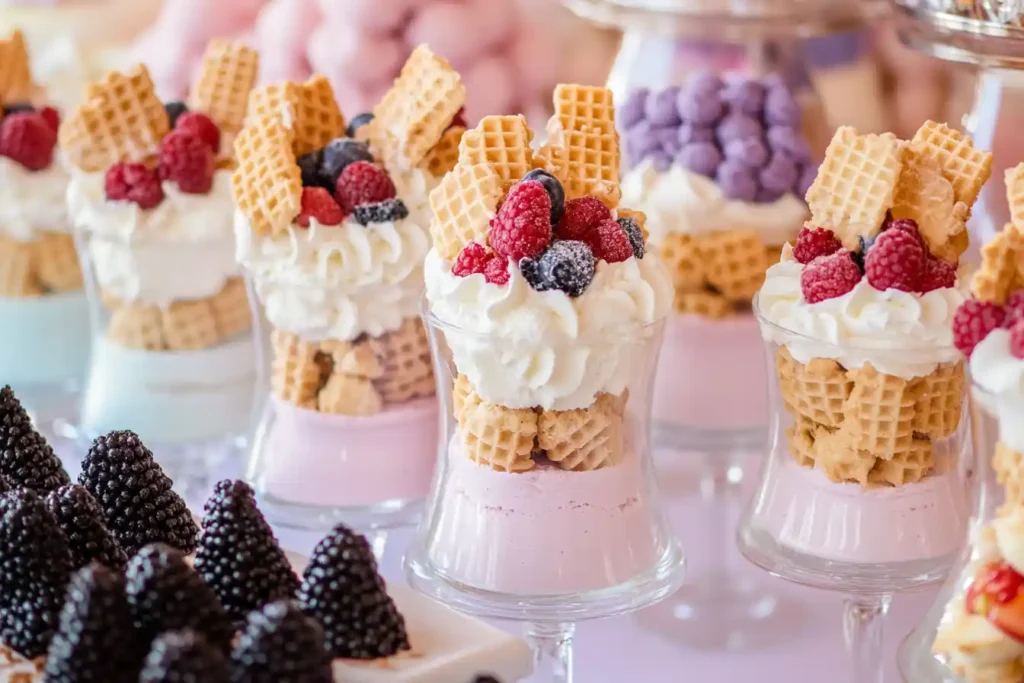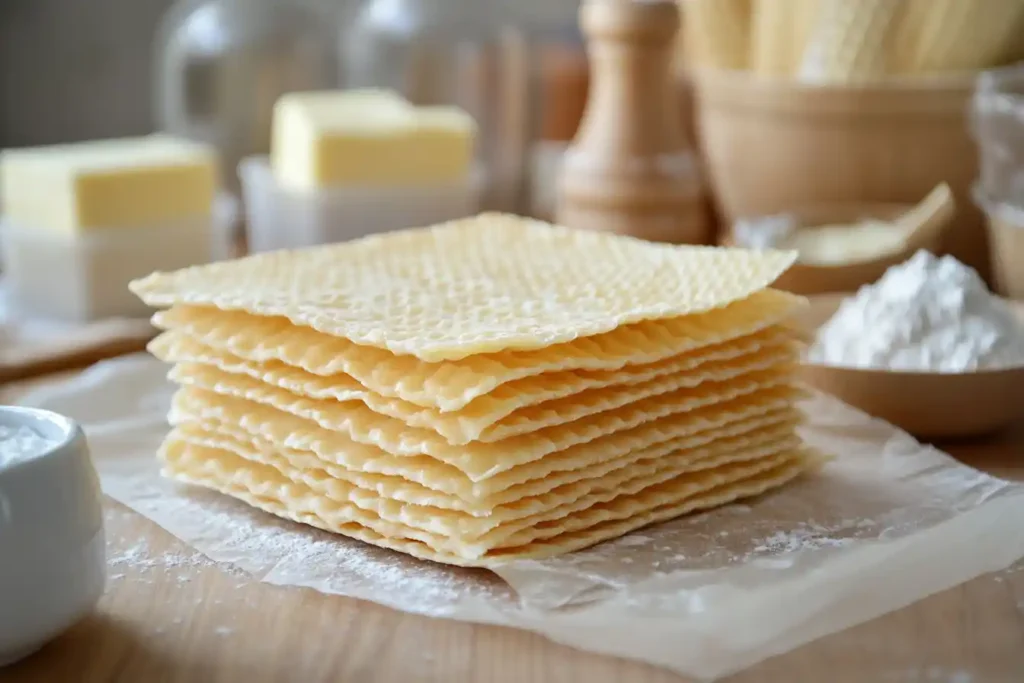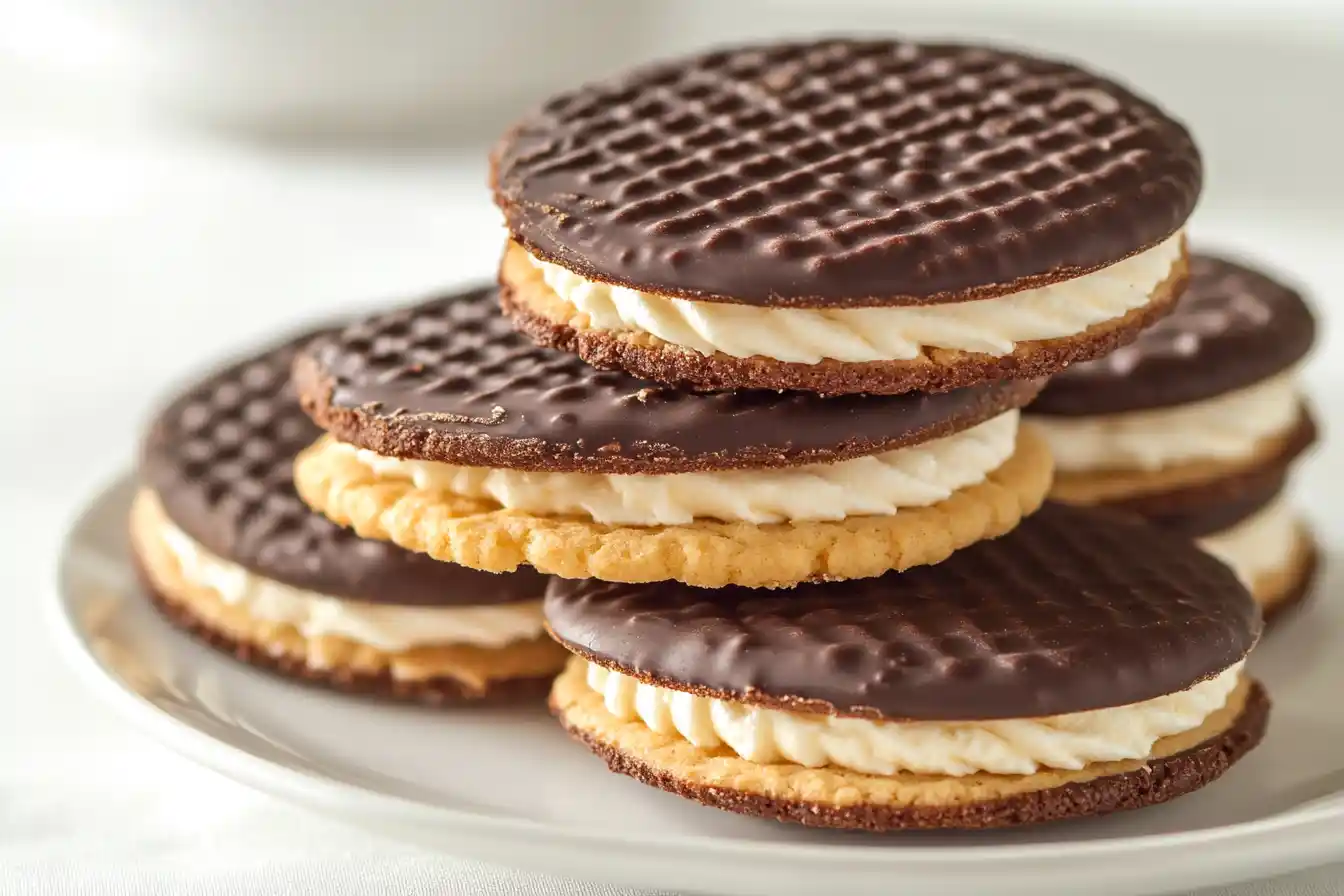Wafer cookies are light, crispy, and widely enjoyed treats. Their delicate texture and sweet flavors make them perfect for snacking or enhancing desserts. Whether served as a standalone treat or layered with creams and chocolate, these thin biscuits have gained worldwide popularity.
Known for their versatility, these crunchy delights fit well in cakes, parfaits, and even ice cream sundaes. Over the years, their flavors and forms have evolved, offering endless varieties to suit different tastes. This guide will dive into their origins, types, recipes, and more.
Table of Contents
The Origin and History of Wafer Cookies
Wafer cookies have a long and fascinating history that traces back to medieval Europe. Originally, wafers were simple flatbread-like pastries cooked on heated irons. These early versions were often served as communion wafers in churches, symbolizing purity and simplicity.
By the 14th century, wafers had transitioned from religious rituals to becoming a delicacy enjoyed during festivals and celebrations. Countries like Belgium, Germany, and Italy perfected wafer-making techniques, giving rise to the crispy, layered cookies we know today.
Fast forward to the 19th and 20th centuries, industrial advancements allowed mass production of wafer cookies. This innovation made them widely accessible and led to the creation of popular brands such as KitKat, Neapolitan wafers, and Stroopwafels.
Wafer cookies have since become a global favorite, embraced for their versatility, portability, and delicious flavor combinations.
Types of Wafer Cookies
These crispy treats come in various shapes, flavors, and styles, making them a versatile snack for any occasion. From timeless favorites to creative modern twists, let’s take a closer look at the most popular types available today.
Classic Wafer Cookies
The most traditional variety features thin, crunchy layers stacked with smooth, creamy fillings. Popular flavors include vanilla, chocolate, and strawberry. These light and airy treats are ideal for snacking or enjoying alongside your favorite drinks.
Chocolate-Covered Wafer Cookies
For chocolate lovers, wafer cookies coated in rich chocolate are a delightful treat. Popular examples include KitKat bars, which combine crispy wafers with smooth chocolate coatings, providing a satisfying crunch with every bite.
Rolled Wafer Cookies
Rolled wafer cookies, often called pirouettes or wafer rolls, are cylindrical and sometimes filled with creams or flavored pastes like hazelnut or caramel. They are ideal for dipping into coffee or decorating desserts.
Flavored Wafer Cookies
Modern varieties include wafers infused with unique flavors such as lemon, matcha, espresso, or coconut. These specialty wafers cater to adventurous palates and add a twist to the traditional snack.
Gluten-Free and Vegan Wafer Cookies
With dietary preferences in mind, manufacturers now produce gluten-free and vegan-friendly wafer cookies. These options allow those with dietary restrictions to enjoy the crunchy goodness without compromising on taste.
Ingredients Used in Wafer Cookies
The simplicity of wafer cookies’ ingredients is key to their light and crisp texture. Let’s take a closer look at what goes into making these delightful treats.
Core Ingredients
- Flour: Typically wheat flour is used to create the light, airy structure of wafers.
- Sugar: Adds sweetness and aids in caramelization during baking.
- Oils and Fats: Vegetable oils or butter provide moisture and contribute to the crispiness.
Flavorings and Additives
- Vanilla Extract: Provides a rich aroma and flavor.
- Cocoa Powder: Used in chocolate wafers for a decadent taste.
- Natural and Artificial Flavors: Enhance the sensory experience, offering unique tastes like coconut, lemon, or hazelnut.
Fillings and Coatings
- Cream Fillings: Often made from powdered sugar, milk, and butter or shortening.
- Chocolate and Caramel: Popular choices for coatings and layered fillings.
Preservatives and Stabilizers
To maintain freshness, commercial wafers may include preservatives like lecithin and emulsifiers that prevent spoilage and improve texture.
How Are Wafer Cookies Made?
The production process of wafer cookies combines traditional baking techniques with modern technology to achieve perfect crispiness.
1: Preparing the Batter
The batter is made by mixing flour, sugar, water, and oil to form a smooth consistency. Flavorings and colors may be added based on the desired outcome.
2: Baking the Wafers
The batter is poured into heated wafer irons or automated molds, which create thin, uniform sheets. These sheets are baked at high temperatures to achieve the signature crisp texture.
3: Layering with Fillings
Once baked, the wafer sheets are layered with creams, chocolates, or pastes. They are carefully aligned to maintain a clean structure when cut into smaller pieces.
4: Cutting and Packaging
The layered wafers are cut into bars, squares, or rolls, depending on the design. Finally, they are sealed in airtight packaging to preserve freshness.
Nutritional Value of Wafer Cookies
Wafer cookies might taste light and airy, but their nutritional value depends largely on the ingredients used. Whether you’re watching your calorie intake or simply curious about their health impact, let’s break down their nutritional profile.
Calories and Macronutrients
A standard serving of wafer cookies usually contains around 150–200 calories per 30-gram portion. Since they are often layered with sugary fillings, they tend to have high sugar and carbohydrate content.
- Carbohydrates: Most wafers contain about 20–25 grams of carbohydrates, which provide quick energy.
- Sugars: Depending on the filling, sugar levels can range between 10–15 grams per serving.
- Fats: With 7–10 grams of fat, including saturated fats, these cookies deliver a creamy texture but should be eaten in moderation.
- Protein: Wafer cookies generally offer 2–3 grams of protein, which is relatively low.
Micronutrients
Wafer cookies don’t pack many vitamins or minerals, but some varieties may include iron or calcium from enriched flours or milk-based fillings. However, these levels are usually small and shouldn’t be considered a primary source of nutrition.
Dietary Concerns
Wafer cookies often contain artificial flavorings, preservatives, and refined sugars. These ingredients may not suit individuals with specific dietary restrictions.
- Gluten-Free Options: Fortunately, gluten-free wafers made with rice or almond flour are now widely available.
- Low-Sugar Alternatives: Some brands reduce sugar content or use natural sweeteners like stevia to cater to health-conscious consumers.
- Vegan Variants: Dairy-free fillings and plant-based oils make vegan-friendly wafer cookies a great option for those avoiding animal products.
Are Wafer Cookies Healthy?
Wafer cookies are best enjoyed as an occasional treat rather than a daily snack. If you’re looking for a healthier option, consider recipes that use whole-grain flours, natural sweeteners, and reduced-fat fillings. These alternatives maintain the crunchy texture while offering better nutritional value.
Popular Uses of Wafer Cookies

Wafer cookies aren’t just snacks—they’re also versatile ingredients that complement various desserts. Let’s explore the different ways people enjoy them.
1. Standalone Snacks
Most people enjoy these light and crunchy treats straight from the pack. Their crisp texture makes them a convenient and tasty snack for both kids and adults.
2. Dessert Layers
Crushed wafers frequently work as a base layer for cheesecakes, pudding cups, or parfaits. Their crumbly texture pairs perfectly with creamy toppings, adding richness and depth to desserts.
3. Ice Cream Toppings
Crumbling wafers over ice cream enhances flavor and texture. Alternatively, rolled wafer cookies are often placed directly into scoops for decoration.
4. Cake Decorations
Pastry chefs use wafer rolls and flat sheets to create intricate cake designs. They also work as edible borders for mousse cakes or tiramisu.
5. Dipping Treats
Wafer cookies pair exceptionally well with coffee, hot chocolate, and milkshakes. Dipping them into these beverages softens their texture, creating a richer flavor experience.
6. Festive Treats
During holidays, many families incorporate wafers into homemade gift boxes and cookie platters. Their attractive designs and rich taste make them a favorite during celebrations.
Comparing Wafer Cookies with Other Cookies
These crisp, layered treats hold a unique place among baked goods, but how do they stack up against other types of cookies? Let’s take a closer look.
1. Wafer Cookies vs. Biscuits
Wafers and biscuits differ in both texture and taste. Biscuits usually have a dense, flaky, or crumbly texture, while wafers deliver a light and crispy crunch, making them ideal for layering with creams and fillings.
Biscuits often complement tea or coffee because of their hearty structure, whereas wafers work better as quick, bite-sized snacks. Additionally, wafers tend to feature sweet, creamy layers, while biscuits focus more on rich, buttery flavors.
2. Wafer Cookies vs. Crackers
Unlike crackers, which often lean toward savory flavors, wafer cookies deliver sweetness and dessert-like qualities. Crackers usually complement cheese spreads or dips, whereas wafers shine as dessert components.
Crackers focus on saltiness and simplicity, while wafers rely on fillings, coatings, and flavor variety. This key difference makes wafers a popular choice for sweet treats rather than savory pairings.
3. Wafer Cookies vs. Sandwich Cookies
Both wafers and sandwich cookies have layered designs, but they differ in texture and structure. Sandwich cookies, like Oreos, use dense and firm biscuit layers to hold fillings, while wafers feature light, airy sheets stacked with creamy layers.
When it comes to versatility, wafers frequently enhance cakes, parfaits, and ice cream sundaes. In contrast, sandwich cookies are typically enjoyed as standalone treats or crumbled into pie crusts and dessert toppings.
Top Brands and Manufacturers of Wafer Cookies
Wafer cookies have captured hearts around the world, and many companies have perfected their recipes. Let’s explore some of the most popular brands producing these tasty treats.
1. KitKat (Nestlé)
KitKat bars combine crispy wafer layers with smooth chocolate coatings. Nestlé manufactures KitKat globally, making it one of the most recognizable wafer products. Their unique design encourages sharing and has become iconic worldwide.
2. Loacker
Originating in Italy, Loacker creates premium wafers in flavors like hazelnut, vanilla, and lemon. Renowned for using natural ingredients and smooth, creamy fillings, Loacker offers exceptional quality and taste.
3. Keebler
The Keebler brand offers a range of wafer cookies, including classic vanilla and chocolate varieties. Their Elf-branded products appeal to children, while their affordable pricing makes them accessible to families.
4. Quadratini (Loacker Sub-Brand)
Quadratini specializes in cube-shaped wafer cookies. These bite-sized snacks often come in resealable bags, making them perfect for on-the-go snacking.
5. Pirouline
Pirouline produces rolled wafer cookies filled with chocolate or hazelnut cream. Their elegant design makes them ideal for gourmet gift boxes and dessert decorations.
6. Local and Artisanal Brands
Around the world, smaller bakeries and local brands create artisanal wafer cookies that showcase regional flavors. These products often emphasize freshness and high-quality ingredients, attracting gourmet snack lovers.
Homemade Wafer Cookie Recipes

Making wafers at home is easier than you might expect. With a few basic ingredients and some patience, you can create crispy, delicious treats that rival store-bought versions. Let’s dive into some simple recipes.
Basic Vanilla Wafer Cookies Recipe
Ingredients:
- 1 cup all-purpose flour
- 1/2 cup powdered sugar
- 1/2 cup unsalted butter (softened)
- 1/4 cup milk
- 1 teaspoon vanilla extract
Instructions:
- Preheat the Oven: Set your oven to 350°F (175°C) and line a baking sheet with parchment paper.
- Mix the Batter: In a large bowl, cream the butter and sugar until smooth. Add the vanilla extract and mix well.
- Add Flour and Milk: Gradually stir in the flour while alternating with the milk. Mix until you get a smooth batter.
- Spread the Batter Thinly: Spread the batter evenly onto the lined baking sheet using a spatula. Keep the layer as thin as possible for crisp wafers.
- Bake Until Golden Brown: Bake for 10–12 minutes or until the edges turn golden brown.
- Cool and Cut: Remove from the oven and let the sheet cool for a few minutes. Cut the wafers into squares or rectangles while they are still slightly warm.
Chocolate-Filled Wafer Cookies Recipe
Ingredients:
- 12 wafer sheets (store-bought or homemade)
- 1 cup melted chocolate
- 1/2 cup heavy cream
- 2 tablespoons powdered sugar
Instructions:
- Prepare the Filling: Mix melted chocolate, heavy cream, and powdered sugar until smooth. Chill the mixture slightly to thicken it.
- Layer the Wafers: Spread a thin layer of chocolate filling between two wafers. Repeat the process to create multiple layers.
- Set and Chill: Stack the layers, press gently, and refrigerate for about 30 minutes to set the filling.
- Slice and Serve: Cut the wafers into bite-sized pieces and enjoy!
Storage and Shelf Life of Wafer Cookies
To keep wafer cookies fresh, proper storage plays an important role. Let’s go over some tips to help you preserve their crunch and flavor.
1. Store in an Airtight Container
Exposure to air makes wafers stale. Placing them in airtight containers prevents moisture from ruining their texture.
2. Keep Away from Heat and Light
Wafers stay fresh longer when kept in a cool, dry place. To prevent melting, store them away from direct sunlight and heat sources.
3. Refrigerate for Longer Storage
If you need to store wafer cookies for more than a week, refrigeration helps maintain freshness. For best results, use resealable bags to prevent odors from affecting their taste.
4. Freeze for Extended Shelf Life
Freezing wafers works well for long-term storage. Wrap them individually in plastic before placing them in freezer bags. Thaw them at room temperature before serving.
5. Avoid Humidity
Humidity softens wafers, making them lose their crisp texture. Adding a food-safe silica gel pack inside the container can absorb moisture and keep them dry.
FAQs about What are wafer cookies?
1. What are wafer cookies made of?
Wafer cookies typically include flour, sugar, vegetable oils, and flavorings. Some varieties also contain cream fillings, chocolate coatings, or fruit-flavored layers to enhance taste.
2. Are wafer cookies healthy?
While wafer cookies taste delicious, they often contain sugar, fats, and preservatives. Eating them occasionally is fine, but consuming them in moderation is best for a balanced diet.
3. How do you keep wafer cookies crispy?
To keep wafer cookies crispy, store them in airtight containers and keep them in a cool, dry place. Avoid exposure to moisture, as it can make them soft.
4. Can you make wafer cookies at home?
Yes, you can! Homemade wafer cookies are easy to prepare with flour, sugar, butter, and vanilla extract. You can also add chocolate or cream fillings for extra flavor.
5. What is the difference between wafer cookies and biscuits?
Wafer cookies are light, thin, and crispy, while biscuits are denser and crumbly. Wafers often feature layered fillings, whereas biscuits may not.
6. Are there gluten-free wafer cookies?
Absolutely! Many brands now offer gluten-free wafer cookies made with rice flour or almond flour to suit dietary needs.
Conclusion
Wafer cookies have remained a popular treat for generations, thanks to their light texture, delicious flavors, and endless versatility. Whether you enjoy them plain, layered with cream, or dipped in chocolate, they make a delightful snack for any occasion.
Their rich history, combined with modern innovations, has transformed wafer cookies into a global favorite. From homemade recipes to commercial brands, these crispy treats continue to satisfy cravings and complement desserts around the world.
Now that you know everything about wafer cookies—from their ingredients to storage tips—why not try making your own batch at home? With so many options available, you’re sure to find a version that fits your taste and lifestyle.
Craving more dessert inspiration? Check out our Cinnamon Roll Cheesecake for a creamy delight, or explore Cupcake Flavors Guide for unique ideas. Don’t miss our tips on Popular Cupcake Flavors to sweeten your menu!

